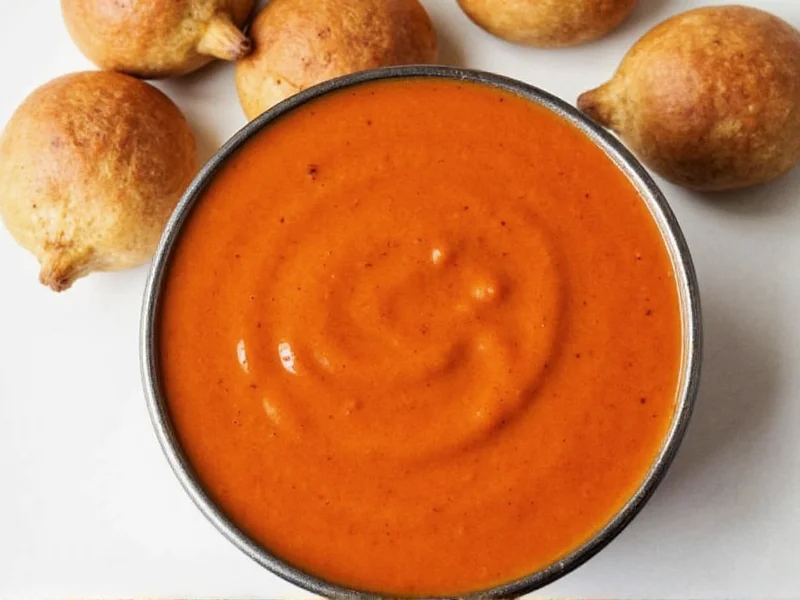What Exactly Is Aji Amarillo?
Aji amarillo ("yellow chili" in Spanish) refers to a specific variety of chili pepper native to Peru. Despite the name, these peppers ripen to a bright orange color rather than yellow. They deliver a unique flavor profile—fruity with tropical notes of apricot and passion fruit, combined with moderate heat (30,000-50,000 Scoville units). Unlike habaneros, aji amarillos provide warmth without overwhelming spiciness, making them versatile for various dishes.
Fresh aji amarillo peppers can be challenging to find outside Latin American markets. Your best alternatives include:
| Ingredient Form | Where to Find | Substitution Ratio |
|---|---|---|
| Fresh peppers | Latin American markets | 4-6 peppers per recipe |
| Frozen peppers | Specialty grocery stores | Same as fresh |
| Aji amarillo paste | Online or Latin markets | 2-3 tablespoons per recipe |
| Habanero + bell pepper | Regular grocery stores | 1 habanero + 1 bell pepper |
Essential Ingredients for Authentic Flavor
Creating genuine Peruvian aji amarillo sauce requires attention to ingredient quality. While substitutions exist, certain elements remain non-negotiable for authentic flavor:
- Aji amarillo base—either 4-6 fresh peppers (stemmed and seeded) or 3 tablespoons of high-quality paste
- Neutral oil—use avocado or vegetable oil rather than olive oil which competes with the delicate pepper flavor
- Fresh garlic—3-4 cloves provide necessary pungency without overpowering
- White vinegar—adds brightness and balances the natural sweetness
- Salt—enhances all flavors without masking the pepper's fruitiness
Step-by-Step Preparation Guide
Follow these precise steps for perfectly balanced aji amarillo sauce every time:
- Prepare 4-6 aji amarillo peppers by removing stems and seeds (wear gloves if handling fresh peppers)
- Combine peppers with 3 garlic cloves, 1 tablespoon vinegar, and ½ teaspoon salt in a blender
- Blend until completely smooth, scraping down sides as needed
- Slowly drizzle in ½ cup oil while blender runs continuously
- Continue blending for 2-3 minutes until emulsified and creamy
- Taste and adjust salt or vinegar as needed
- Strain through fine mesh sieve for ultra-smooth texture (optional but recommended)
Pro Tips for Perfect Consistency and Flavor
Professional chefs rely on these techniques to elevate their aji amarillo sauce:
- Emulsification matters—add oil gradually while blender runs to create stable emulsion
- Temperature control—use room temperature ingredients for best blending results
- Balancing acidity—if sauce tastes flat, add vinegar ½ teaspoon at a time until vibrant
- Heat adjustment—retain some seeds for extra heat, or add a pinch of sugar to mellow intensity
- Flavor development—let sauce rest 2 hours before serving to allow flavors to meld
Culinary Applications in Peruvian Cuisine
Aji amarillo sauce serves as the flavor foundation for numerous Peruvian dishes. Use it in these authentic ways:
- Ceviche accompaniment—serve alongside fresh fish ceviche as leche de tigre alternative
- Marinade base—combine with lime juice and cumin for chicken or fish
- Sauce component—mix with mayonnaise for ocopa sauce or with cream for huancaína
- Dipping sauce—pair with boiled potatoes (papas a la huancaína) or grilled meats
- Pasta enhancement—toss with spaghetti and Parmesan for Peruvian-style pasta
Storage Guidelines and Shelf Life
Proper storage maintains both safety and flavor quality:
- Refrigerate in airtight container for up to 2 weeks
- Freeze in ice cube trays then transfer to freezer bags for 6 months
- Always use clean utensils when serving to prevent contamination
- Discard if mold appears or if sauce develops sour odor
- Thaw frozen sauce overnight in refrigerator before use
Common Substitutions and Adaptations
When authentic ingredients prove difficult to source, consider these thoughtful adaptations:
- Fresh pepper substitute—use 1 habanero pepper plus 1 yellow bell pepper for similar heat and color
- Vegan adaptation—ensure all ingredients remain plant-based (traditional recipe already is)
- Oil-free version—replace oil with additional vinegar and blend longer for creaminess
- Milder version—remove all seeds and membranes from substitute peppers
- Spicier variation—add ½ teaspoon of aji panca paste for deeper heat profile
Troubleshooting Common Issues
Solve these frequent preparation challenges:
- Sauce too thin—blend longer to develop natural starches or add 1 teaspoon cornstarch slurry
- Bitter aftertaste—you likely included too many seeds; balance with ¼ teaspoon sugar
- Separation occurs—re-blend with 1 teaspoon vinegar to re-emulsify
- Flavor too sharp—let sauce rest 4 hours to mellow; add touch of honey if needed
- Color fades—store in dark glass container away from light to preserve vibrant orange hue
Frequently Asked Questions
Can I make aji amarillo sauce without fresh peppers?
Yes, you can use frozen aji amarillo peppers or high-quality aji amarillo paste as substitutes. For paste, use 2-3 tablespoons per recipe. If unavailable, combine 1 habanero pepper with 1 yellow bell pepper for similar flavor profile and color.
How spicy is authentic aji amarillo sauce?
Authentic aji amarillo sauce has moderate heat (30,000-50,000 Scoville units) with prominent fruity notes. The heat level is comparable to a serrano pepper but with tropical fruit undertones. You can adjust spiciness by retaining or removing seeds from the peppers.
What dishes pair best with aji amarillo sauce?
Aji amarillo sauce complements grilled chicken, fish ceviche, boiled potatoes (papas a la huancaína), and roasted vegetables. It also works as a marinade base, pasta sauce component, or dipping sauce for empanadas. Traditional Peruvian pairings include causa limeña and anticuchos.
Why did my sauce separate after refrigeration?
Separation occurs when the emulsion breaks, typically from adding oil too quickly. To fix this, blend the separated sauce with 1 teaspoon vinegar until re-emulsified. For prevention, add oil in a slow, steady stream while the blender runs continuously.
Can I freeze aji amarillo sauce for long-term storage?
Yes, aji amarillo sauce freezes exceptionally well. Pour into ice cube trays, freeze solid, then transfer cubes to freezer bags. Properly stored, it maintains quality for 6 months. Thaw overnight in the refrigerator before use for best texture and flavor retention.











 浙公网安备
33010002000092号
浙公网安备
33010002000092号 浙B2-20120091-4
浙B2-20120091-4